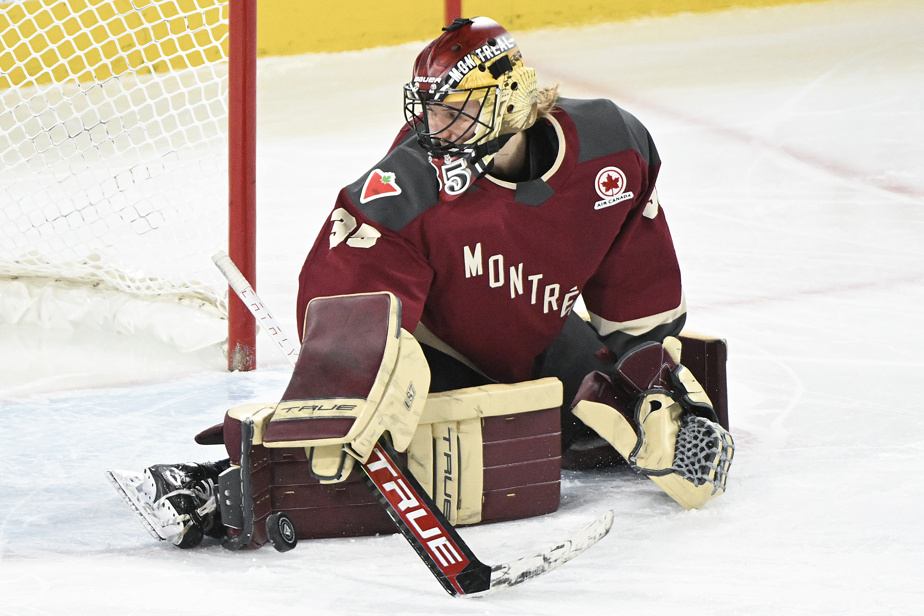Given the significant disparity between teams in the quality of their development programs, major international women’s hockey events generally feature high-scoring matches.
At the 2022 Beijing Olympic Games, Canada scored 33 goals in 4 preliminary matches. At the most recent World Championship, the United States scored 25 times, also in 4 games.
It didn’t take long to realize that the Professional Women’s Hockey League (LPHF) shows a completely different face. Each goal is sold dearly.
Since the start of the season, in the LPHF, teams have scored an average of 2.39 goals per game. This is almost half a goal less than in the defunct PHF (2.88) and LCHF (2.87) in their last two seasons of existence (2021-2023 and 2017-2019, respectively).
Maureen Murphy, attacker playing for the Montreal team, did not hesitate on Thursday when she was asked to explain the phenomenon.
It speaks to the quality of the goalkeepers. There are only 18 in the league, coming from all over the world. So they are all good.
Maureen Murphy, forward for the Montreal team
“If they are at all able to see the puck, they will make the saves,” added Ann-Sophie Bettez.
The goalkeepers, in fact, are the big stars of the league so far. Among the ten who have played at least one game, eight have an efficiency rating of .913 or higher. Montrealers Ann-Renée Desbiens and Elaine Chuli, together, have a rate of .941. As an indication, the average success rate of an NHL goalie, in 2023-2024, is .904.

PHOTO ABBIE PARR, ASSOCIATED PRESS
Montreal goalkeeper Elaine Chuli
” Several things “
Head coach Kori Cheverie, although she recognizes the “remarkable” performances of the goalkeepers, points to a more structural phenomenon. “A combination of several things,” she explains. Every puck is fiercely contested and the game is very physical; despite everything, few penalties are imposed, so that opportunities to play on the power play are rare.
And again, even when a player is chased, few goals are scored: four of the six teams converted less than 10% of their chances into the power play.
Bettez emphasizes that the aggressive forecheck makes excess zone exits rare. She recalls to what extent “the talent is distributed in the league”, which gives an obvious “parity”. In fact, after 8 to 10 matches, no team has a goal differential greater than +3 or less than -4. For comparison purposes, after nine games this season, the Vancouver Canucks were +15, and the San Jose Sharks were -25.
“It made for close matches and a good show,” summed up the attacker.
We should also keep in mind that the season is barely a month and a half old, which includes two full breaks of five and ten days, during which international matches have been played.
“It’s good to have a break, but you find yourself playing with other teammates in other systems,” said Maureen Murphy. We are still adjusting. And before the season started, many of us hadn’t played in six or eight months. »
Concentrated production
With 22 goals in 9 games, Montreal’s attack is essentially league average.
However, it mainly focuses around two players. Marie-Philip Poulin (6) and Laura Stacey (5) indeed scored half of their club’s goals. No other attacker has scored more than one. Among the defenders, only Erin Ambrose (2) found the back of the net.

PHOTO JUSTIN TANG, CANADIAN PRESS ARCHIVES
Marie-Philip Poulin (29) and Laura Stacey (7) scored half of the Montreal team’s goals.
To this observation, Kori Cheverie retorts that the team she leads comes second in terms of the number of players having scored at least one goal. This is not false, but with 12 scorers, Montreal actually finds itself in a three-way tie behind Boston. Ottawa, also at 12, played one game less.
Cheverie also notes that his flock leads the circuit in five-on-five goals. This is also true, and in this regard, the trend is clearer. “I’m not worried,” summarizes the pilot.
Among those who we might believe could contribute more, we will think of Ann-Sophie Bettez.
After producing at a rate of at least one point per game wherever she has been in her career, the Quebecer has shown a relatively modest performance so far, with three points, including two goals, in seven games.
No one wants the pressure to fall “only on two or three players,” she concedes. His own statistics, however, don’t keep him from sleeping.
“If I steal a puck on the back foot or cut off a pass and it prevents a goal, it doesn’t show up on the scoresheet, but it’s important to me,” she said. This is how I see it game. But it’s certain that if I can get more points, I won’t say no! »
Head to Toronto
Immediately after their practice on Thursday, the Montrealers headed to Toronto where they will face the local team Friday evening at Scotiabank Arena, home of the Maple Leafs. This duel, which will be played in front of a sold-out crowd in front of more than 18,000 people, will set an attendance record for a women’s hockey match. Kori Cheverie expects a crazy atmosphere, possibly more than for a Leafs game – Toronto spectators know how to keep a low profile at home. “The fans in our league are really loud,” she greeted with a smile. Friday’s record could be broken if a game were presented at the Bell Center, noted a journalist. “If I were a member of the administration, I know what I would do! “, replied goalkeeper Ann-Renée Desbiens. Note here that the league playoffs will begin at the beginning of May. And as we know, no current tenant of the Bell Center will still play hockey after mid-April.
